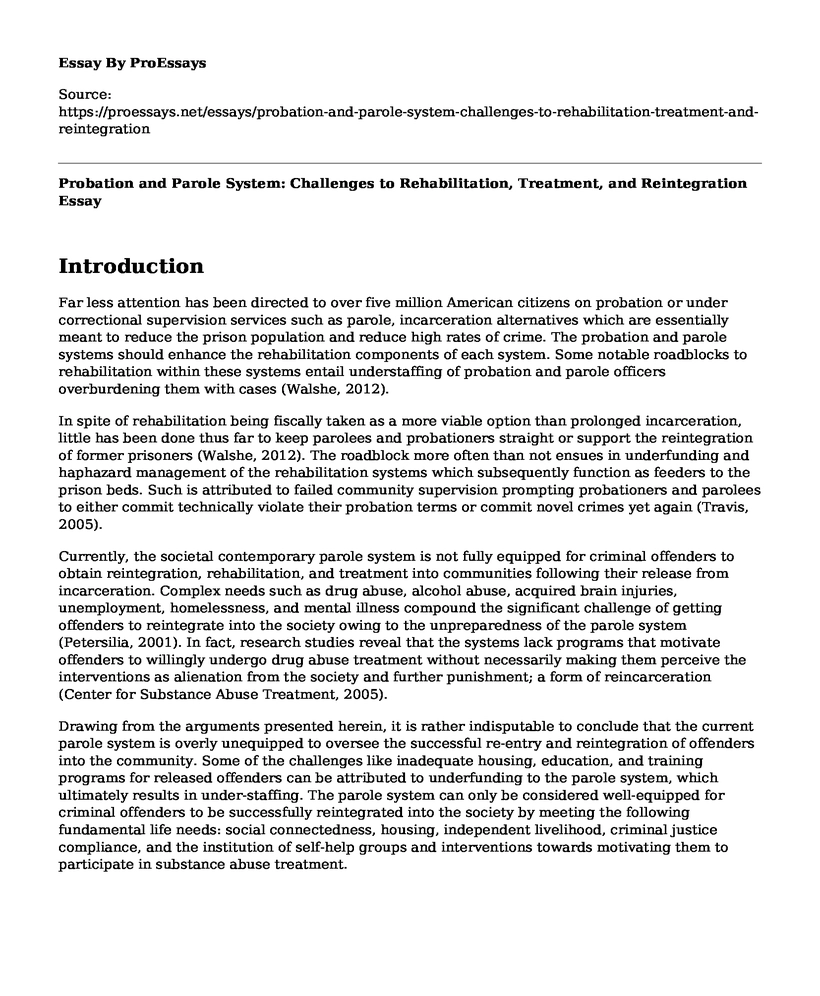Introduction
Far less attention has been directed to over five million American citizens on probation or under correctional supervision services such as parole, incarceration alternatives which are essentially meant to reduce the prison population and reduce high rates of crime. The probation and parole systems should enhance the rehabilitation components of each system. Some notable roadblocks to rehabilitation within these systems entail understaffing of probation and parole officers overburdening them with cases (Walshe, 2012).
In spite of rehabilitation being fiscally taken as a more viable option than prolonged incarceration, little has been done thus far to keep parolees and probationers straight or support the reintegration of former prisoners (Walshe, 2012). The roadblock more often than not ensues in underfunding and haphazard management of the rehabilitation systems which subsequently function as feeders to the prison beds. Such is attributed to failed community supervision prompting probationers and parolees to either commit technically violate their probation terms or commit novel crimes yet again (Travis, 2005).
Currently, the societal contemporary parole system is not fully equipped for criminal offenders to obtain reintegration, rehabilitation, and treatment into communities following their release from incarceration. Complex needs such as drug abuse, alcohol abuse, acquired brain injuries, unemployment, homelessness, and mental illness compound the significant challenge of getting offenders to reintegrate into the society owing to the unpreparedness of the parole system (Petersilia, 2001). In fact, research studies reveal that the systems lack programs that motivate offenders to willingly undergo drug abuse treatment without necessarily making them perceive the interventions as alienation from the society and further punishment; a form of reincarceration (Center for Substance Abuse Treatment, 2005).
Drawing from the arguments presented herein, it is rather indisputable to conclude that the current parole system is overly unequipped to oversee the successful re-entry and reintegration of offenders into the community. Some of the challenges like inadequate housing, education, and training programs for released offenders can be attributed to underfunding to the parole system, which ultimately results in under-staffing. The parole system can only be considered well-equipped for criminal offenders to be successfully reintegrated into the society by meeting the following fundamental life needs: social connectedness, housing, independent livelihood, criminal justice compliance, and the institution of self-help groups and interventions towards motivating them to participate in substance abuse treatment.
References
Center for Substance Abuse Treatment. (2005). Substance abuse treatment for adults in the criminal justice system.
Petersilia, J. (2001). Prisoner re-entry: Public safety and reintegration challenges. The Prison Journal, 81(3), 360-375.
Travis, J. (2005). But they all come back: Facing the challenges of prisoner reentry. The Urban Insitute.
Walshe, S. (2012). Probation and parole: a study in criminal justice dysfunction | Sadhbh Walshe. the Guardian. Retrieved 16 August 2018, from https://www.theguardian.com/commentisfree/cifamerica/2012/apr/26/probation-parole-study-dysfunction
Cite this page
Probation and Parole System: Challenges to Rehabilitation, Treatment, and Reintegration. (2022, Jul 27). Retrieved from https://proessays.net/essays/probation-and-parole-system-challenges-to-rehabilitation-treatment-and-reintegration
If you are the original author of this essay and no longer wish to have it published on the ProEssays website, please click below to request its removal:
- Childhood Trauma and Criminal Behavior: An Annotated Bibliography
- Value in Healthcare Essays
- Essay Sample on Sicilian Mafia
- U.S. Marijuana Use: Federal vs. State Laws - Research Paper
- Essay Example on Nina Simone's Impact on the Civil Rights Movement
- Research Paper Example on Feminist Theory: Understanding Social Justice and Equality
- Insights on the Death Penalty: A Brief Review of Scholarly Perspectives - Annotated Bibliography Sample







